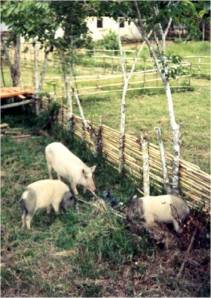Freddy Pattiselanno (Animal Production Laboratory, Universitas Negeri Papua, Manokwari)
Pigs are the mostly highly valued animals, both socially and culturally, in Papuan society. The subject of this particular study is the tradition
of pig rearing, a skill which is handed down from generation to generation. Traditional pig rearing has been the subject of a previous study by the
Animal Science Department of Universitas Negeri Papua (UNIPA) who conducted research in various parts of Papua. In our study we focussed on development of local pig husbandry within the framework of the traditional system. Our study was financially supported by an outreach grant from the Mennonite Central Committee (MCC) in collaboration with the Center of Voluntary Services (Pusat Pengabdian Pada Masyarakat) of UNIPA.
One aspect of traditional pig rearing of particular interest and concern is the genetic contamination of wild pig populations in Papua. In our preliminary studies in Kebar we found that it is quite common for domestic pigs to breed with free ranging feral and/ or wild pigs, either deliberately managed or
accidentally. The purpose of this paper is to present the information obtained from our study and to provide a basis for conducting research on hybridisation of wild pig with free ranging feral or domesticated pig.
Our findings:
 1. Pigs are usually raised within a backyard farming system, fenced in and in close proximity to the house (Figure 1). Their diet consists of both cooked and uncooked kitchen and household leftovers, such as rice, vegetables and root crops. Pigs are also raised in agricultural plots located far from the house. These plots may be previous swidden areas with some crops still remaining, which the pigs lives off. Here the pig performs the dual function of maintaining the soil through digging
1. Pigs are usually raised within a backyard farming system, fenced in and in close proximity to the house (Figure 1). Their diet consists of both cooked and uncooked kitchen and household leftovers, such as rice, vegetables and root crops. Pigs are also raised in agricultural plots located far from the house. These plots may be previous swidden areas with some crops still remaining, which the pigs lives off. Here the pig performs the dual function of maintaining the soil through digging
and fertilizing the soil through its faeces. After a certain period the pig will be removed and placed in another swidden area.
2. Pregnant sows receive priority attention and as such are kept close to the dwellings and given good quality food and shelter. Sometimes the sows live within the house receiving special treatment such as baths (Figure 2). 
3. Where people live far from the main village
and have access to more land, livestock are raised in a much more free-ranging style around the house and garden. In these situations pigs often searched for their own food utilising areas right up to the forest edge. It was not uncommon in these situations for female domestic pigs to mate with wild boars, a chance happening which the farmers did not actively try to avert. It is believed that the offspring of such mixtures are more aggressive, produce good quality meat, and are stronger than pure domestic pigs in terms of immunity to diseases, finding food, and reproduction.
Such outcomes mean that farmers are quite in favour of crossbreeding. An additional benefit is that farmers do not need to practice the dangerous activity of hunting wild boar as much because they have a good source of meat from the crossbred pigs.
The crossbred offspring receive special treatment due to the wild behaviour inherited from the sire. These piglets are bathed intensively, most often
rubbed with banana leaves) warmed on the fire. In addition these piglets are given a tour of the surrounding area from the luxury of a small basket (noken basket made from plant fibres) on the owners back or with a rope tied round their neck like a lead (Figure 3).
Note: Article has been published in Suiform Soundings PPHSG Newsletter Vol 4 (1): 19-20, May 2004

